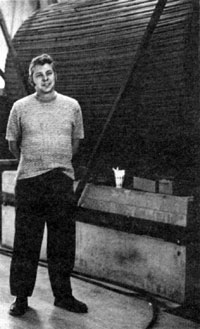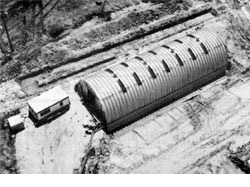NAL, Caltech Join in Neutrino Studies (Experiment 21)
NAL experienced an interesting, significant and challenging transitional phase - from early construction to operations; from building to research; from bricks and mortar to scientific investigation.
One of the first assignments before the world's most powerful particle accelerator was the complex search for a new particle that would help describe nature's mysterious weak nuclear force.
Discovery of such a particle would indicate striking similarities between the weak force and at least two of the three other fundamental forces of nature - the strong nuclear force and the electrical force. Both of these forces have specific particles associated with them, and perhaps the remaining one, gravity, does also.
Experiment 21, the goals of which are described in simple terms above, was an NAL-California Institute of Technology collaboration. It was a novel experiment of Barry C. Barish, 35 years old, and Frank Sciulli, 32, associate and assistant professors, respectively, at Caltech. They worked with Alfred W. Maschke, head of NAL's Beam Transfer section, in what was one of the first experiments to be undertaken on the proton synchrotron at NAL. They were selected to investigate neutrino physics during the initial operation of the accelerator and continued until January, 1973. The Caltech-NAL researchers planned to carry their studies on neutrinos up to about 300 BeV. In July 1971, data existed only up to about 10 BeV.
The nature of the weak force remains something of a mystery. It is associated with radioactive decay, and its interactions are many billions of times slower and weaker than those of the strong nuclear force, which binds together the protons and neutrons in an atom's nucleus.
It was the research team's plan to seek a particle that could carry the weak force. It already has been named. It is called variously the "W," the "Ux1," or the "intermediate vector boson."
Evidence suggests the W has a mass greater than that of two protons; this means that the weak force interacts over the extremely short distance of four quadrillionths of an inch or less. The higher the mass of the W, the more difficult it is to produce.
The Caltech-NAL experiment, supported by the U.S. Atomic Energy Commission, hoped to produce and detect the particle if its mass is less than about 20 proton masses. The high energy of NAL's new accelerator system makes this possible - if the particle exists.
Said Dr. Sciulli: "We were able to probe more deeply than hitherto possible into the proton and the neutron. This helped us understand more about their structures and the forces associated with them. We may learn more about the electrical force because indications are that the weak force is related to it."
A small but distinguished group of physicists conducted the experiment at NAL with Barish, Sciulli and Maschke. They include Les Oleksiuk of the NAL Beam Transfer section; and from Caltech: Charles Peck, associate professor of physics; Yorikiyo Nagashima, senior research fellow; William Ford. Dennis Shields (research fellow) and Tom Humphrey, thesis student. George Krafczyk, NAL technician, assisted in installing the experiment.
Members of the Caltech physics faculty and several Caltech students came to NAL in March 1971, preparing for this early experiment. They worked in what was a cornfield between Batavia and McChesney Roads and to the east of Wilson Road. The lights rarely went off at the "Wonder Building"; they were on day and night, weekdays and weekends, as the team completed the special equipment designed and built for this experiment. The "Wonder Building" had a dirt floor, no framing, and featured bottled water and chemical toilets. It was truly an austere "Wonder Building" but it contained some of the most advanced scientific equipment for elementary particle research in the world.
During the school term at Caltech, the faculty members commuted from California to NAL, in order to maintain their teaching commitments and to prepare for the experiment at the same time. The Barish, Nagashima, and Sciulli families then resided in the Surrey Hill apartments in St.Charles; the Caltech students working with the project lived at "The Pad" - a dormitory-type facility located at 32 Sauk in the NAL Village. The professors and their families returned to California in the fall and resumed their commuting-teaching-experimenting schedule.
Robert R. Wilson, NAL Director, told the NAL Users' Organization, at their annual meeting, that the first aim of experiments on the NAL accelerator system was the detection of a neutrino. "I feel that we then will be in business to do experiments on our accelerator, and I feel that this detection will come in the Caltech-NAL experiment. The Caltech installation excites my envy - their enthusiasm and improvisation gives us a real incentive to provide them with the neutrinos they are waiting for."
The new accelerator made it possible for the first time to observe the behavior of the weak nuclear force at high energies. In July 1971, knowledge of this force was based primarily on decays of heavy particles at low energies. Drs. Barish, Sciulli and Maschke developed a very high energy beam of neutrinos - a product of weak force interactions - for this investigation. The beam was unique in that its design allowed the experimenters to specify the energy of the neutrinos that they wished to investigate.





